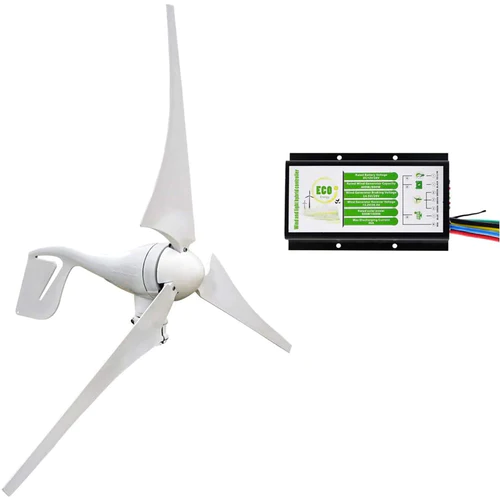We disconnected from the national energy grid just three weeks ago, and it’s already evident that our system needs a boost.
With the rainy season around the corner, the available sunlight hours will soon drop, leaving us struggling to power our lights and appliances.
Adding more solar panels won’t help, but supplementing our existing solar system with a micro wind turbine could be the answer.
You can add a wind turbine to an existing solar system relatively easily, provided you’ve got all the right components.
These include the wind turbine, a charge control unit, and a hybrid inverter.
Charge Control Units for Hybrid Wind/Solar Systems

Although we have an existing solar charge control unit, this won’t work with a wind turbine because it can’t dump its excess load.
While both wind and solar charge control units protect the battery from overcharging, a wind charge control unit is slightly more complex because of the mechanical nature of the turbine.
Solar panels convert light into energy using photovoltaic cells. There are no moving parts, and when the solar panel is disconnected, the circuit remains open, meaning no electrons are transferred.
Without that transfer process, there is no current, so the solar panel generates no power.
A wind turbine continues to create power regardless of whether or not it’s connected. The blades will keep rotating and the gearbox operating even if the power has nowhere to go.
When this happens, the power builds up inside the turbine instead, heating the entire system. This process can cause the motor to burn out.
Because of the mechanical nature of the wind turbine, the control charge unit must be able to divert or dump that excess load.
For us, that means adding a second charge control unit to manage power from the generator.
It is possible to get hybrid charge controllers that can handle multiple energy sources, but as our solar charge controller is only a few weeks old, replacing it at this stage doesn’t make financial sense.
How a Hybrid Inverter Works
An inverter transforms the power from your energy source from direct current to alternating current.
Most domestic solar systems use hybrid solar inverters that can use power either from solar panels or battery storage.
Our inverter can also take power from an auxiliary source which, at present, is our backup generator.
To add a wind turbine into our system, we can use our existing inverter by adding the turbine as a new auxiliary power source.
If your inverter lacks this capacity, you’ll need to replace it with a hybrid inverter that can take power from auxiliary sources, as well as your solar panels and battery.
Wiring a Wind Turbine into an Existing Solar System
The best way to include your wind turbine into an existing solar system is by using the same wiring system. To do this, you will need a hybrid charge controller that can handle both systems.
Alternatively, you can wire the wind turbine separately using a different charge controller for each energy source and, potentially, a manual change-over switch.
This is possible with a hybrid inverter that accepts auxiliary power sources, provided that the wind turbine produces direct current at the correct voltage.
You should not attempt to do the wiring yourself, as this stage of the installation is both critical and potentially dangerous. Getting a qualified professional to do the job for you will minimize the risk and ensure your system works effectively.
Read our guide to the best wind turbines for home use.
Expanding your Solar vs Adding a Wind Turbine
We covered some of the pros and cons of a hybrid wind/solar system in a previous article, but here are a few additional points to consider before adding a wind turbine to your existing solar system:
Reliability vs Productivity
Having two energy sources makes your off-grid power supply more reliable. Chances are that when the sun’s not shining, the wind is blowing, so you’re always generating electricity, even at night.
On the downside, micro wind turbines suitable for domestic use rarely perform at their optimum, and industry estimates suggest they function at around 30-40% capacity.
That means installing a 1Kw turbine will only guarantee you around 400 to 400w of power, whereas a single solar panel will produce an average of 1.35Kw per day.
For us, that’s not a factor, as we’re looking to produce energy on overcast days when solar isn’t an option.
If we had a larger battery to store our solar power, increasing the number of panels could prove more cost-effective than adding a wind turbine.
Legality
The recommended height for micro wind turbines is 65 feet; anything lower than this will be negatively affected by surrounding buildings and trees.
As we live in a rural area, this isn’t a problem for us, but if you live in a residential area, there may well be zoning restrictions that prevent you from installing one.
You may also need to apply for a building permit from your local government before you can install your wind turbine.
Read more about the off-grid laws in your state.
Noise
One of the most common concerns regarding micro wind turbines in the US is the amount of noise they produce.
People looking at adding a turbine to an existing solar system worry that they, and their neighbors, will be exposed to the kind of relentless low-frequency noise sometimes associated with wind farms.
Fortunately, micro wind turbines are much quieter than you imagine. Modern turbines “emit sound that is barely discernible from ambient noise, even with a decibel (dB) meter“.
You might just notice the sound of your turbine over the ambient noise, but that’s about it.
Maintenance Costs
Unlike solar panels, wind turbines have lots of moving parts that need regular maintenance. According to this insightful video, the combined costs of replacing oil, grease, and filters, along with routine mechanical and electrical checks, amounts to around 1.5% to 2% of the turbine’s original cost.
If your wind turbine costs $8,000, that would mean an annual outlay of between $120 and $160 for maintenance. Solar power has virtually no maintenance costs because the panels have no moving parts to take care of.
If it’s an option, adding additional solar panels could prove more cost-effective than switching to a hybrid system.
Conclusion
It is possible to add a micro wind turbine to your existing solar system, provided you have both a charge controller and inverter that can handle the two systems.
Although there are downsides to using wind energy, such as installation and maintenance costs, legal restrictions, and poor productivity, it’s also one of the fastest-growing renewable energy sources in the world.
If you decide to create a hybrid system by adding a wind turbine to your solar system, resist the urge to do it yourself. This magnitude of energy needs a professional to install it safely and ensure all the components are operating effectively.



Our excess solar is “banked” and goes back into the grid, can a turbine be hooked up to this type of system? Thanks
Thank you for a great article on adding wind to a solar system. Many wind turbines include a charge controller of their own. Their outputs connect directly to battery storage.
Our solar system has a charge controller connected to our battery bank, could we wire the additional wind charge controller to the same battery bank in parallel? Therefore having two charge controllers, one from the solar side, one from the wind side?
This is a big help but I still have to read more an talk to a good electrical person